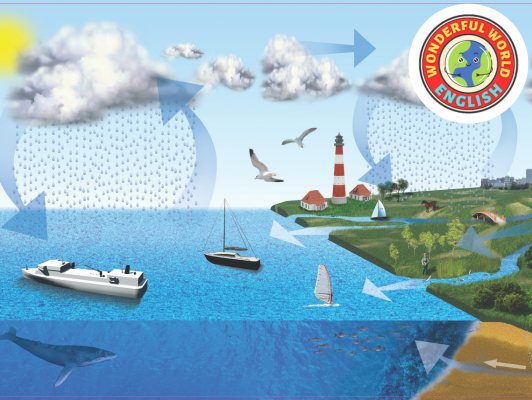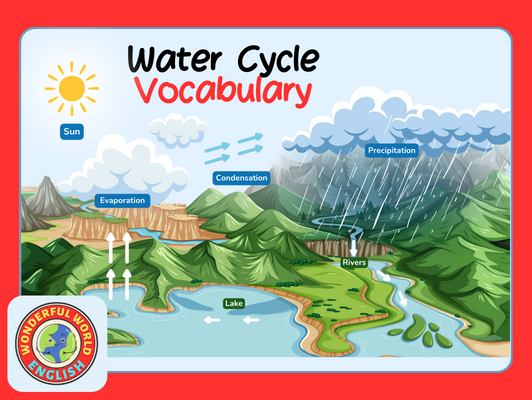Contents
Toggle
Meet David De’ Ath, founder, editor, and writer at Wonderful World English. With his extensive background as an English teacher, David provides valuable insights and practical tips on ESL for students and teachers alike.
Understanding the water cycle vocabulary is essential to grasping how water moves through the Earth’s system.
The water cycle, also known as the hydrologic cycle, describes the continuous movement of water above, on, and below the Earth’s surface.
It is a complex process that involves various stages, each with its specific terminology.
Key terms such as evaporation, condensation, precipitation, and infiltration illustrate the different processes that water undergoes.
Evaporation refers to the transformation of water from a liquid to a gaseous state, often leading to the formation of clouds through condensation.
Precipitation occurs when these condensed water droplets fall to Earth due to gravity in various forms, including rain, snow, sleet, or hail.
Moreover, terms like transpiration, the release of water vapor from plants, and runoff, water that flows over the land surface, are fundamental for understanding how water interacts with the biosphere and lithosphere.
As one delves into the water cycle vocabulary, it becomes clear how vital each aspect of this cycle is for sustaining life on Earth, proving it to be an endlessly fascinating subject that underpins many scientific disciplines.
Fundamentals of the Water Cycle
Understanding the water cycle is essential to grasp how water moves through different states and environments on Earth.
It’s a cycle powered by the sun, involving the continuous flow of water from the atmosphere to the ground and back again.
State Transitions
Water can exist in three states: solid (ice or snow), liquid (water), and gas (water vapor). The transitions between these states are driven by heat energy from the sun and occur in various processes:
- Evaporation: When the sun’s heat energy causes liquid water from oceans, lakes, and rivers to transform into water vapor and ascend into the atmosphere.
- Condensation: As water vapor rises and cools, it changes back into liquid form, creating clouds.
- Sublimation: This is the direct transition from solid to gas, bypassing the liquid state, commonly seen in snowand ice subject to intense sunlight or low-pressure conditions.
- Freezing: Conversely, when water vapor cools, it can directly become solid, forming ice. However, when freezing rain occurs, the liquid droplets freeze upon contacting a cold surface.
These state transitions are integral to the water cycle’s mechanics, facilitating the movement and energy transferwithin the Earth’s hydrological system.
Water in Motion
The movement of water within the cycle involves several key stages:
- Precipitation: Water falls from clouds in the form of rain, snow, or freezing rain.
- Infiltration: Some of this water seeps into the ground, replenishing groundwater reservoirs.
- Runoff: The rest flows over the surface, returning to bodies of water like oceans and rivers.
- Transpiration: Plants contribute to the cycle by releasing water vapor from their leaves into the atmosphere.
| Term | Definition |
|---|---|
| Evaporation | The process of water transitioning from a liquid to a gaseous state due to heat energy, typically from the sun. |
| Condensation | The process where water vapor cools and changes back into liquid form, often leading to cloud formation. |
| Precipitation | Water released from clouds in the form of rain, snow, sleet, or hail that falls to the Earth’s surface. |
| Infiltration | The process by which water on the ground surface enters the soil, replenishing groundwater. |
| Runoff | Water that flows over the land’s surface and returns to bodies of water like rivers, lakes, and oceans. |
| Transpiration | The release of water vapor from plants into the atmosphere, contributing to the water cycle. |
| Sublimation | The transition of water from a solid (ice or snow) directly to a gaseous state (water vapor) without becoming liquid. |
| Freezing | The process of water transitioning from a liquid to a solid state, forming ice. |
| Snowmelt | The runoff of water resulting from melted snow and ice. |
| Groundwater | Water that is stored underground in soil pore spaces and in the fractures of rock formations. |
| Thermal pollution | The degradation of water quality by a process that changes ambient water temperature, often due to human activities. |
Impacts and Interactions
Throughout the water cycle, interactions with the climate, weather, and human activities have profound impacts on how water transitions between its various states and locations.
These influences not only dictate the quality and quantity of water but also affect global and regional weather patterns and ecosystems.
Climate and Weather Influence
Climate and weather play a decisive role in the water cycle by affecting heat transfer and evapotranspiration rates.
These atmospheric conditions determine how much water vapor the air can hold, influencing condensation to form clouds and precipitation.
- For instance, warm temperatures can increase the rate of evaporation from earth’s surface, contributing to a higher flux of atmospheric moisture.
- Heat from the sun or warm air can cause snowpacks and glacier ice to melt, referred to as snowmelt, releasing freshwater into lakes and soil.
- When cool air interacts with a warm lake, it can trigger condensation, leading to the formation of cloud layers and precipitation.
Human Influence and Usage
Human activity has a substantial impact on the natural movements of water within the water cycle.
Through the construction of reservoirs, dams, and the extraction of water for agriculture, irrigation, livestock, and power generation, humans actively redistribute and alter water availability.
- Agricultural practices drastically change soil moisture levels and patterns of groundwater recharge.
- Water moves through aquifers and into underground streams, but these can be depleted or contaminated due to overuse and pollution, affecting water quality.
- Thermoelectric power generation requires significant volumes of water, which can alter the temperature of lakes and streams, leading to thermal pollution.
- Urbanization seals surfaces, increasing runoff and reducing permafrost and pool recharge.
For some great suggestions of water safety activities for your classroom, check out the link below!
Related: Water Safety Activities in the Classroom – Teacher’s Tips

Conclusion
Understanding the water cycle vocabulary is crucial for comprehending the intricate ways water circulates through Earth’s systems, influencing climate, ecology, and human life.
The cycle’s stages—evaporation, condensation, precipitation, and more—highlight the dynamic processes that sustain our planet’s water balance.
Grasping these terms allows us to appreciate the water cycle’s role in supporting life, maintaining ecosystems, and shaping weather patterns.
As we delve into the water cycle’s complexities, we uncover the interconnectedness of natural phenomena and human activities, emphasizing the need to safeguard our water resources for future generations.
This understanding enhances our knowledge of Earth’s hydrological processes and underscores our responsibility to protect and manage water sustainably in the face of environmental challenges.
We hope you find value in this information; you can contact us if you require any support.
Have a wonderful day!
Image Attribution: All images licensed via canva.com





